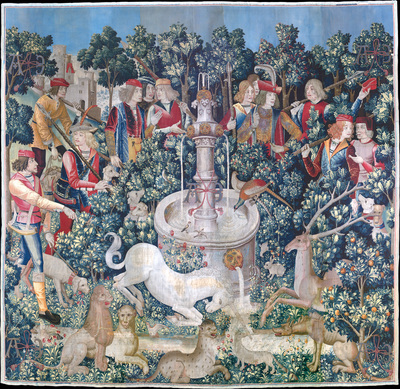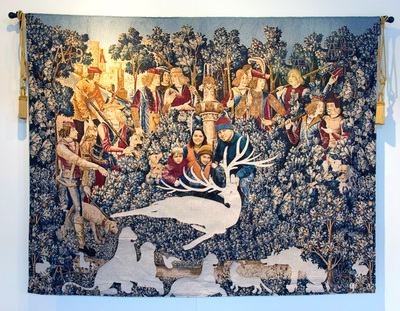The Trophy is Found, 60" x 50," printed tapestry, 2014
Hunting scenes were a major theme of Medieval and Renaissance tapestries, which were commissioned by kings and noblemen who used them as visual markers of wealth, conquest and power. The fabled white unicorn was a popular allegorical symbol in many of these tapestries, used to denote pagan and Christian symbolism, most notably the Passion of the Christ. In the well-known “The Hunt of the Unicorn” tapestry series, the unicorn is hunted, killed, and resurrected (acts that recall the death and resurrection of Christ) because the unicorn’s horn is said to possess mythical powers, such as rendering poisoned water potable and healing the sick.
Stories pronouncing the so-called “mythical powers” of imaginary creatures like the unicorn are not a relic of the past, but are very much at work today as real flesh and blood animals’ are hunted to extinction and killed so that their heads, horns, and bodies can be used as decorative status symbols or as medical “cures” to increase virility and treat other bodily ailments.
The Trophy is Found reimagines The Unicorn is Found, one of the seven tapestries in “The Hunt of the Unicorn” tapestry series. This machine- woven consumer-grade version of The Unicorn is Found interrogates the history of class distinctions in hunting culture, the anthropocentrism that is at the heart of trophy hunting and the role that trophy hunting has played in the extinction of species.
Stories pronouncing the so-called “mythical powers” of imaginary creatures like the unicorn are not a relic of the past, but are very much at work today as real flesh and blood animals’ are hunted to extinction and killed so that their heads, horns, and bodies can be used as decorative status symbols or as medical “cures” to increase virility and treat other bodily ailments.
The Trophy is Found reimagines The Unicorn is Found, one of the seven tapestries in “The Hunt of the Unicorn” tapestry series. This machine- woven consumer-grade version of The Unicorn is Found interrogates the history of class distinctions in hunting culture, the anthropocentrism that is at the heart of trophy hunting and the role that trophy hunting has played in the extinction of species.

